1. Overview of Meaning
The kanji “罷” (pronounced “hi” or “ba”) generally means to stop, cease, or dismiss. It is often used in contexts related to quitting or resigning from a position or duty.
2. Formation and Radical
Formation of the Kanji: The kanji “罷” is a compound character (会意文字) that combines elements to convey its meaning. It consists of the radical for “clothing” (衣) and the character “非” (hi), which can imply negation or stopping.
Radical: The radical of “罷” is 衣 (clothing), which often relates to garments or attire in various kanji.
3. Examples of Usage
Common Words and Phrases: Some common phrases that include “罷” are “罷免” (himen – dismissal) and “罷業” (hagyō – strike or work stoppage).
Example Sentences in Daily Conversation:
- 彼は仕事を罷免された。 (Kare wa shigoto o himen sareta.) – He was dismissed from his job.
- 彼女はそのプロジェクトを罷業することに決めた。 (Kanojo wa sono purojekuto o hagyō suru koto ni kimeta.) – She decided to go on strike for that project.
4. Synonyms and Antonyms
Similar Kanji: A similar kanji is “辞” (ji), which also means to resign or quit, but it is more commonly used in the context of leaving a job voluntarily rather than being dismissed.
Opposite Kanji: An antonym is “続” (zoku), which means to continue or persist, representing the opposite action of stopping or ceasing.
5. Cultural and Historical Background
Relation to Japanese Culture: The concept of “罷” is significant in Japanese culture, especially in the context of labor movements and the importance of workers’ rights. It reflects the historical struggles for fair treatment in the workplace.
Proverbs and Idioms: One relevant idiom is “罷り通る” (mari tōru), which means to go unchallenged or to be allowed to continue, often used in discussions about authority and compliance.
